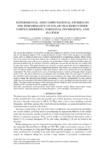Mostrar o rexistro simple do ítem
Experimental and Computational Studies on the Performance of Solar Trackers Under Vortex Shedding, Torsional Divergence, and Flutter
| dc.contributor.author | Quintela Suárez, Juan | |
| dc.contributor.author | Jurado, José Ángel | |
| dc.contributor.author | Rapela Ponte, Carlos | |
| dc.contributor.author | Álvarez Naveira, Antonio José | |
| dc.contributor.author | Roca Rodríguez, Miguel | |
| dc.contributor.author | Hernández, Santiago | |
| dc.contributor.author | Cid Montoya, Miguel | |
| dc.contributor.author | López Rodríguez, Juan María | |
| dc.contributor.author | Ruiz Moreno, Antonio Jesús | |
| dc.contributor.author | Moreno Echarri, Itxaso | |
| dc.contributor.author | Jiménez Romero, Sergio | |
| dc.date.accessioned | 2021-01-15T20:20:55Z | |
| dc.date.available | 2021-01-15T20:20:55Z | |
| dc.date.issued | 2020 | |
| dc.identifier.citation | Quintela, J. (2020). Experimental and computational studies on the performance of solar trackers under vortex shedding, torsional divergence, and flutter. International Journal of Computational Methods and Experimental Measurements, 8(4), 387-404. DOI: 10.2495/CMEM-V8-N4-387-404 | es_ES |
| dc.identifier.uri | http://hdl.handle.net/2183/27164 | |
| dc.description.abstract | [Abstract] The current development of renewable energies has originated a number of new structural typologies that are the physical support of the energy production systems. Photovoltaic energy is a very mature source and it is obtained using rows of panels implemented in a longitudinal grillage. Many studies have been carried out in the past with an aim to improve the capacity to obtain electrical power, but another important issue is the need to guarantee the performance of these industrial facilities under the phenomena induced by the turbulent wind flow, taking into account the fact that they are usually built in wide open spaces. This paper describes an extensive research carried out on two configurations of solar trackers by experimental and computational methods. The former was composed of a number of tests of reduced models of segments of the solar trackers, which were carried out in an aerodynamic wind tunnel. The latter consisted of a series of structural analyses worked out through a finite element model of the full panel subjected to aerodynamic and aeroelastic loads. Several angles of attack of the wind flow and a wide range of wind speeds were included in the study. This approach allowed to clearly evaluate the structural and dynamic performance of both the configurations of solar trackers under the most important wind-induced phenomena such as vortex shedding, torsional divergence, and flutter. The paper relates the phases of the study and informs about the more relevant numerical results obtained in the experiments and the computer analysis. | es_ES |
| dc.language.iso | eng | es_ES |
| dc.publisher | WIT Press | es_ES |
| dc.relation.uri | https://doi.org/10.2495/CMEM-V8-N4-387-404 | es_ES |
| dc.rights | Copyright: WIT Press | es_ES |
| dc.subject | Aerodynamic and aeroelastic loads | es_ES |
| dc.subject | Finite elements models | es_ES |
| dc.subject | Flutter | es_ES |
| dc.subject | Photovoltaic energy | es_ES |
| dc.subject | Solar trackers | es_ES |
| dc.subject | Structural analysis | es_ES |
| dc.subject | Torsional divergence | es_ES |
| dc.subject | Vortex shedding | es_ES |
| dc.subject | Wind tunnel test | es_ES |
| dc.title | Experimental and Computational Studies on the Performance of Solar Trackers Under Vortex Shedding, Torsional Divergence, and Flutter | es_ES |
| dc.type | info:eu-repo/semantics/article | es_ES |
| dc.rights.access | info:eu-repo/semantics/openAccess | es_ES |
| UDC.journalTitle | International Journal of Computational Methods and Experimental Measurements | es_ES |
| UDC.volume | 8 | es_ES |
| UDC.issue | 4 | es_ES |
| UDC.startPage | 387 | es_ES |
| UDC.endPage | 404 | es_ES |
| dc.identifier.doi | 10.2495/CMEM-V8-N4-387-404 |
Ficheiros no ítem
Este ítem aparece na(s) seguinte(s) colección(s)
-
CITEEC-ME - Artigos [28]






